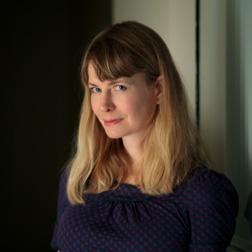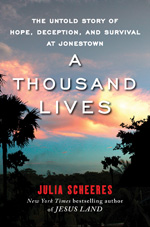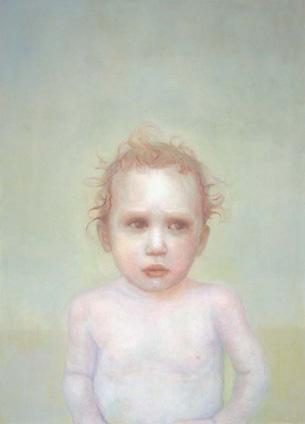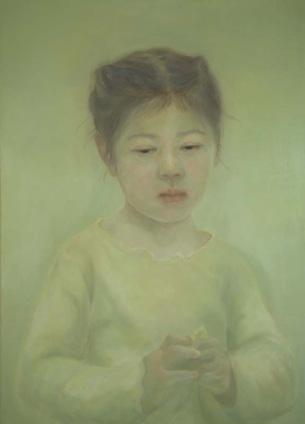TW Interview by William Gray
Shedding New Light on Jonestown
“Don’t drink the Kool-Aid” is about all that’s left of Jonestown in the daily lexicon. But I’m 27. I can’t put down A Thousand Lives by Julia Scheeres, because I'm amazed that Jonestown even happened. It reads like a carefully crafted alternate history—a glimpse into a world I’ve never experienced, where cell phones, the Internet, and airport security don’t exist.
 In this alternate reality, it’s 1977. A megalomaniac televangelist named Jim Jones, who got his start in Indianapolis and moved to California in the mid-1960s, convinces more than a thousand people to leave their homes, travel to the South American country of Guyana, and commit mass suicide at his command.
In this alternate reality, it’s 1977. A megalomaniac televangelist named Jim Jones, who got his start in Indianapolis and moved to California in the mid-1960s, convinces more than a thousand people to leave their homes, travel to the South American country of Guyana, and commit mass suicide at his command.
And, as someone who works in television and is electronically connected to everyone and everything, I cannot imagine the assassination in a foreign country of a Congressman who was inquiring into a religious organization on behalf of his constituents. Yet Congressman Leo Ryan was killed in 1978 doing just that, gunned down on an airport runway in Guyana after visiting Jonestown because there was no other way for him to find out what was going on there.
The killing sparked Jones’ final—and fatal—order to his disciples to drink the poisoned Kool-Aid.
Today, a Google search would turn up more than anyone would ever need to learn about a person like Jim Jones and his Peoples Temple. Who today would go to another country to investigate an isolated compound without conducting due diligence on its leader?
But Scheeres portrays the environment of the time—the racial tensions, the desire to feel part of a community of shared beliefs—with excruciating detail. And she paints a new and disturbing portrait of Jim Jones through the journals, survivor stories, videos, and photographs now available. I knew the ending before I began, but her close attention to detail made me hope for a different outcome.
Scheeres is the author of Jesus Land, a memoir about Scheeres and her adopted black brother, David, in the 1970s, charting a course from public school to a Christian reform school in the Dominican Republic. In Scheeres’s own words, “It’s a pretty wild ride between these two events.”
 In A Thousand Lives, Scheeres works on a much larger canvas. She tells the story of five Peoples Temple members. They include Stanley Clayton, a rage-filled young man from a broken family in Oakland; the deeply faithful Thrash sisters, Hyacinth and Zipporah, who traveled across the United States to join Jones’s church before following him to South America; Tommy Bogue, a teenager, who frequently rebelled against Jim Jones and Jonestown; and Edith Roller, a college-educated progressive in her sixties.
In A Thousand Lives, Scheeres works on a much larger canvas. She tells the story of five Peoples Temple members. They include Stanley Clayton, a rage-filled young man from a broken family in Oakland; the deeply faithful Thrash sisters, Hyacinth and Zipporah, who traveled across the United States to join Jones’s church before following him to South America; Tommy Bogue, a teenager, who frequently rebelled against Jim Jones and Jonestown; and Edith Roller, a college-educated progressive in her sixties.
Some survived Jonestown, and some did not. Edith Roller was one who died, but she wrote thousands of pages in her journals about her time with the Peoples Temple.
When I interviewed Scheeres by phone last November, just after A Thousand Lives was released, I sought to elicit her feelings about Jonestown. Plenty of photographic and video evidence—such as tapes of life at Jonestown, heavily edited ‘pitch’ videos Jones showed to followers in the United States, and audio recordings of Jones preaching—can be found on YouTube, but Scheeres is one of the few who is intimately familiar with all the material.
Maybe I wanted her to illuminate the darkness of a tragedy that happened over three decades ago and is now embedded in cultural lingo. As someone in his mid-twenties who covers politics, this event fascinates me on both the national scale of conflicting governments and the local scale of the role of religion in public life. But I found that the enormity of Jonestown, both from the surviving evidence and its aftereffects, is difficult to quantify.
As Scheeres quotes Jones at the beginning of A Thousand Lives:
I love socialism, and I’m willing to die to bring it about, but if I did, I’d take a thousand with me.
TW: So, let’s start at the beginning. What do you want people who read this book to come away with?
JS: I hope people come away with renewed conclusions about Jonestown—that they didn’t “drink the Kool-Aid.” I hope they find that phrase offensive. For decades now, the residents of Jonestown have been stigmatized as lunatics and cultists. One cultural historian, Susan Jacoby, has referred to them as the “psychotic Kool-Aid drinkers of Jonestown.” After you read the book, you’ll have a sense of how trapped they were and how methodical Jim Jones was, how he orchestrated that last night.
TW: How many besides you have read all the primary source material?
JS: I’m one of two people who’ve read through the FBI documents in their entirety.
TW: How long have they been available?
JS: There’s a woman, Rebecca Moore, who teaches religious studies at San Diego State and who lost two sisters and a nephew in Jonestown. She and her husband, Fielding McGehee, began in October 1998 to press the FBI (through Freedom of Information Act requests) to make the files public. She’s an academic, so she’s written these academic books. I wanted to write a popular history that was accessible to everyone.
TW: You have five narratives in the book. Did you fit in everyone you wanted to?
JS: I had to take people out. I had to have clean lines and focus on my five people. The hardest thing was to take out information—notes to Jim Jones from people who hated it at Jonestown. But my editor said I had to cut it out because it was bogging down the narrative. I had to cleanly focus on my five people and their characters and that journey.
TW: What about the interviews with the survivors?
JS: Tommy Bogue would only speak with me after he read Jesus Land and realized we had some parallels. It’s getting past that initial impression and fear. Time has helped survivors come forward and heal.
TW: Could Jonestown happen again?
JS: I think it would be really hard to isolate that number of people again. I had better cell phone reception in Port Kaituma [in Guyana] than in my apartment. I think people are savvier now, and you can go online and do research.
TW: What’s left of Jonestown today?
JS: It’s an overgrown field with artifacts—rusted-out pieces of tractor. It’s empty.
JS: I do. I talk in the book about those in Guyana turning it into a tourist destination. They are so poor. They get a lot of the tourism from media going to Jonestown to do these stories every couple of years. They’re talking about rebuilding parts of Jonestownto make it an amusement park. I think it’s wrong for people to get off on the fear of Jonestown.
TW: Should it be left as is? Should there be a memorial? Should the survivors decide what is there?
JS: I think it should be left as an overgrown field. I do believe that the people of Jonestownshould be memorialized, and I hope that the book is part of that effort to respect their dignity and humanity. Almost a third of the people who died were children. Jones wasn’t going to let anybody get out alive. It was either drink this potion or be shot with an arrow or a bullet.
They erected a memorial at the mass gravesite in Oakland [California]. The name of everyone who died that day was inscribed on the stone, including Jim Jones. Among the people who raised the money was his son, Jim Jones, Jr. There’s a clash to this day. There are some people who want to believe that Jim Jones, Sr., was a CIA agent. They can’t believe the simple truth that he was a mass murderer who wanted to kill.
TW: What drove you to write the book in this way?
JS: I made a conscious decision to not make this about Jim Jones; enough ink had been spilled on him. He bored me. He was not interesting. He was an evil man.
But wouldn’t you like to be a member of Jones’s church, to espouse racial equality and social justice? What was it like to be trapped down there? And then Jim Jones is saying you’re going to have to kill yourself?
That’s what compelled me and drew me in: the rank and file. The regular church members who thought they would go down there, check it out, and come back if they didn’t like it.
TW: Your book details the political and media leverage that Jones had. Could he have done this without that influence?
JS: He controlled them in a lot of ways. He was a power broker in San Francisco. That helped him when allegations arose about financial mismanagement and physical abuse in the church. These politicians refused calls to investigate.
TW: What about the current survivors? What is their response? The response to the memorial?
JS: They’re divided. He had a whole group of people supporting him and enabling him, so where do you stop taking names off this memorial? My argument is that all these people would probably not have orchestrated a mass suicide or mass murder if they hadn’t met Jim Jones.
TW: Why do you think the rank and file were interested in Jones?
JS: He had a very powerful message. It was one of social justice and integration, and he was forceful with his words. There’s a church in San Francisco named Glide [Memorial], with the Reverend Cecil Williams, and you walk in and the pews are integrated, blacks and whites, everyone sitting next to each other. At one point during the service, you stand up and talk to people and walk around—and you’re breaking down these racial barriers. That’s how it was in Jones’s time. I think that was the magic of the Peoples Temple.
TW: Jones appeared on television, and you write about members of the Temple first seeing him on TV. What impact do you feel television had?
JS: He was obviously able to reach a much bigger audience with his message. Here we are in segregated Indianapolis, and we have this one and only integrated church. He’s integrating his own family, adopting a black child for example; he’s bucking the law. I think one of the questions for researchers is: Did he ever have an altruistic streak—or did he happen upon these people who were vulnerable?
 TW: How did you feel as a writer when you saw the staged videos and photos that were sent back to the United States, showing Jonestown as a virtual Eden?
TW: How did you feel as a writer when you saw the staged videos and photos that were sent back to the United States, showing Jonestown as a virtual Eden? JS: They put you in the scene. And you can describe it. That’s the great thing about having the audio and the video, especially the video. You can actually put yourself in the scene and observe all the effort he was putting into fooling these people.
TW: And from a historical perspective, what were the reactions of Temple members to living in Jonestown?
JS: There’s not enough food. He’s telling them that they’re going to die. He’s not giving them free time. There are pauses in the tapes, and we don’t know what was being said in those pauses. We don’t know what was being said. What we do know is that it was a hellhole.
TW: Did you get a sense from the journals that the followers felt Jonestown was not at all what they signed up for?
JS: It was a failure; it was a miserable failure. It was pretty obvious that everyone wanted to leave; it wasn’t just the five in the book.
TW: What went through your head when you read Edith Roller’s journal?
JS: I read through years of her journal. Most of it was very boring—I knew about her bowel movements—then every once in awhile you’d read a line about Jim Jones wanting to kill people. That was probably the most helpful source I had.
TW: Was writing the book cathartic?
JS: I wouldn’t say cathartic, because I didn’t have any personal stake in Jonestown. It was satisfying, like a puzzle, figuring out the book and the structure and my way in. It was satisfying.
TW: What value did conducting interviews with the survivors have for you?
JS: It was great. Papers can be dry and tell a linear tale, but you can interview someone to talk about the emotional undertones of the event, and you can query them about an event.
TW: And what about newspapers and media coverage of the time?
JS: Newspapers didn’t have access to these files, and it was a rush to get things out.
TW: Now that all this is available, should newspapers bring the story full circle and address this for the 35th anniversary?
JS: They won’t. They’re news-driven. They may give it nine inches or a minute, but that’s it.
TW: Will your book help rewrite the narrative?
JS: That’s what I’m hoping. That they won’t come across as lunatics and cultists. I want people to realize that there was no way out for the people at Jonestown.
The journey up the coastline was choppy, the shrimp trawler too far out to get a good look at the shore. While other passengers rested fitfully in sleeping bags spread out on the deck or in the berths below, 15-year-old Tommy Bogue gripped the slick railing, bracing himself against the waves. He'd already puked twice, but was determined not to miss a beat of this adventure. The constellations soared overhead, clearer than he'd ever seen them. He wiped salt spray from his eyes with an impatient hand and squinted at the horizon. He was still boy enough to imagine a pirate galleon looming toward them, the Jolly Roger flapping in the Caribbean breeze.
—From A Thousand Lives, Julia Scheeres
Art Information
- “No Words” and “Where Do I Go from Here” © Cynthia Frost; used by permission

